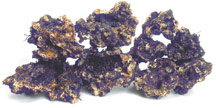
Thanks to its vibrant colors, interesting inhabitants, and water clarification benefits, live rock continues to grow in popularity among aquarists. Each year, aquarists add thousands of pounds of live rock to new or existing reef aquariums. Live rock, while a huge benefit to reef aquariums, requires you to perform a few extra steps - especially curing - to ensure the health of your reef inhabitants.
What is live rock?
Live rock is actually small pieces of old coral reefs that were naturally broken off during storms or by wave action. These pieces then washed into shallower water where they were colonized with naturally occurring marine life - invertebrates, corals, sponges, and millions of beneficial nitrifying bacteria. All varieties of live rock available on LiveAquaria.com are harvested with the highest ethical standards and removed passively from the ocean floor - not manually broken off of any live or existing reefs.
Where does live rock come from?
Live rock can come from anywhere in the ocean. The varieties of live rock found on LiveAquaria.com come primarily from the pristine waters of the Indo-Pacific area, with the majority coming from Fiji and Tonga.
Must I cure my live rock?
 You must cure your live rock, even if it arrives precured. Precured live rock is harvested, then continually sprayed with a mist of sea water and scrubbed to remove unwanted debris. The spray tends to drive out unwanted species such as bristle worms and mantis shrimp. Uncured live rock contains a wider variety of organisms. Either type of rock can work great in your home reef aquarium. Regardless of whether your rock arrives uncured or precured, you must cure your rock in its new aquarium.
You must cure your live rock, even if it arrives precured. Precured live rock is harvested, then continually sprayed with a mist of sea water and scrubbed to remove unwanted debris. The spray tends to drive out unwanted species such as bristle worms and mantis shrimp. Uncured live rock contains a wider variety of organisms. Either type of rock can work great in your home reef aquarium. Regardless of whether your rock arrives uncured or precured, you must cure your rock in its new aquarium.
Why must I cure my live rock?
Live rock must be cured to allow the plant and marine life - especially sponges which were living on the rock - to undergo a natural die back without polluting the aquarium water. This die back occurs in all transported live rock and is necessary to provide a solid foundation for the remaining species to grow and flourish. As the organisms on the rock go through a die back, they will produce a large amount of waste material and cause toxic levels of ammonia to be released into the aquarium. Most of the very beneficial nitrifying bacteria survive the curing process by hiding deep in the pores and crevices of the live rock. In addition, some of the corals and invertebrates will also not die off completely and will begin to re-emerge in the new aquarium over time.
How do I cure my live rock?
While you may cure your live rock in many different ways, the following method has been shown to be very effective. Curing typically takes from one to three weeks.
- Place the live rock in a new 30-gallon plastic garbage can.
- Cover the rock completely with freshly mixed saltwater.
- Use a heater to keep the water temperature near 80 degrees to speed die off.
- Create constant water movement with a powerhead or air stone.
- Keep the area dimly lit to prevent algae blooms.
- Perform 100% water changes twice a week.
- Scrub the rock between water changes to remove dead material.
- Consider adding bottom drains to the container to speed draining and water changes.
- Check water quality and test for ammonia. When ammonia tests are negative, the rock is safe for your aquarium.
What happens if I don't cure it properly?
If you add improperly cured rock to your aquarium too quickly, it will still be in the process of a die back, which can harm (if not kill) existing tank inhabitants with toxic levels of ammonia. In addition, if you do not maintain proper aeration and temperature during the curing process, then high levels of beneficial nitrifying bacteria will die, reducing the initial effectiveness of the rock as a biological filter. Live rock is not difficult to cure properly and the benefits of high quality live rock are well worth the effort. Be sure to follow the simple steps above, and you can be confident that you are adding clean, healthy live rock to your aquarium.
|